There are approximately 600 volcanic features scattered throughout Arizona. Two of the most popular active volcanic fields are San Fransisco and Uinkaret Fields. In fact, the tallest volcano in Arizona is part of one of these active volcanic fields. But there’s no need to worry about volcanoes in Arizona erupting any time soon. Keep reading to discover the tallest volcano in Arizona, if it’s still active, and why it’s important to the people of Arizona.
Where to Find the Tallest Volcano in Arizona
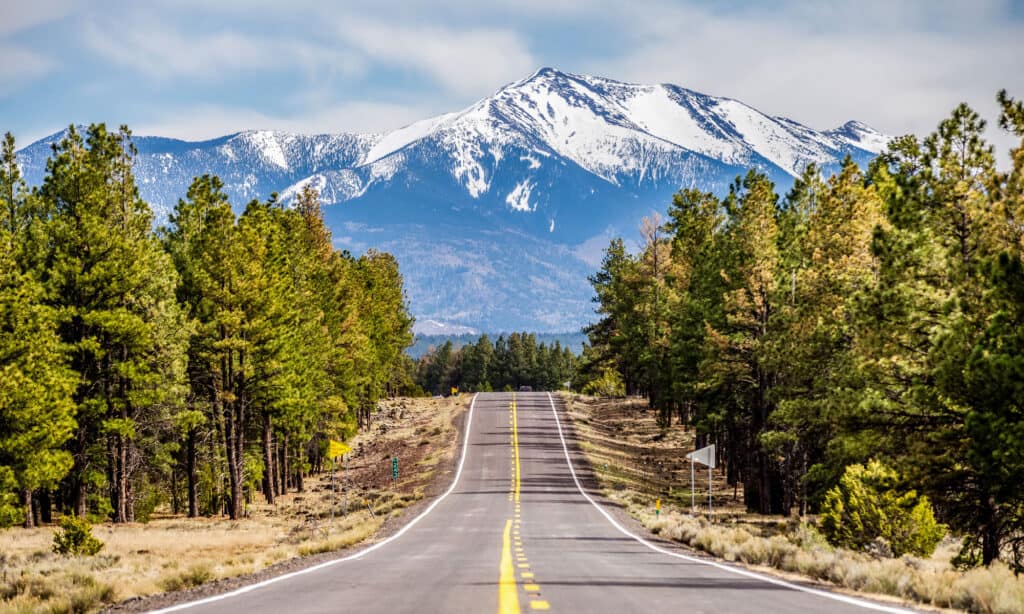
The tallest volcano in Arizona is in the Coconino National Forest near Flagstaff.
©iStock.com/digidreamgrafix
The tallest volcano in Arizona is Humphreys Peak in the Kachina Peaks Wilderness within the Coconino National Forest, near Flagstaff. It’s the highest natural point in Arizona at 12,633 feet and the second most prominent peak in the state behind Mount Graham. Humphreys Peak is part of the San Francisco Mountain, a stratovolcano in the San Francisco Volcanic Field.
The San Francisco Peaks are large conical volcanoes created by alternative layers of hardened lava due to multiple eruptions over thousands of years. The mountain range was created nearly one million years ago and was much taller than it is today. The Peaks are the remainder of the eroded San Francisco Mountain, which may have stood over 16,000 feet.
History of the Tallest Volcano in Arizona
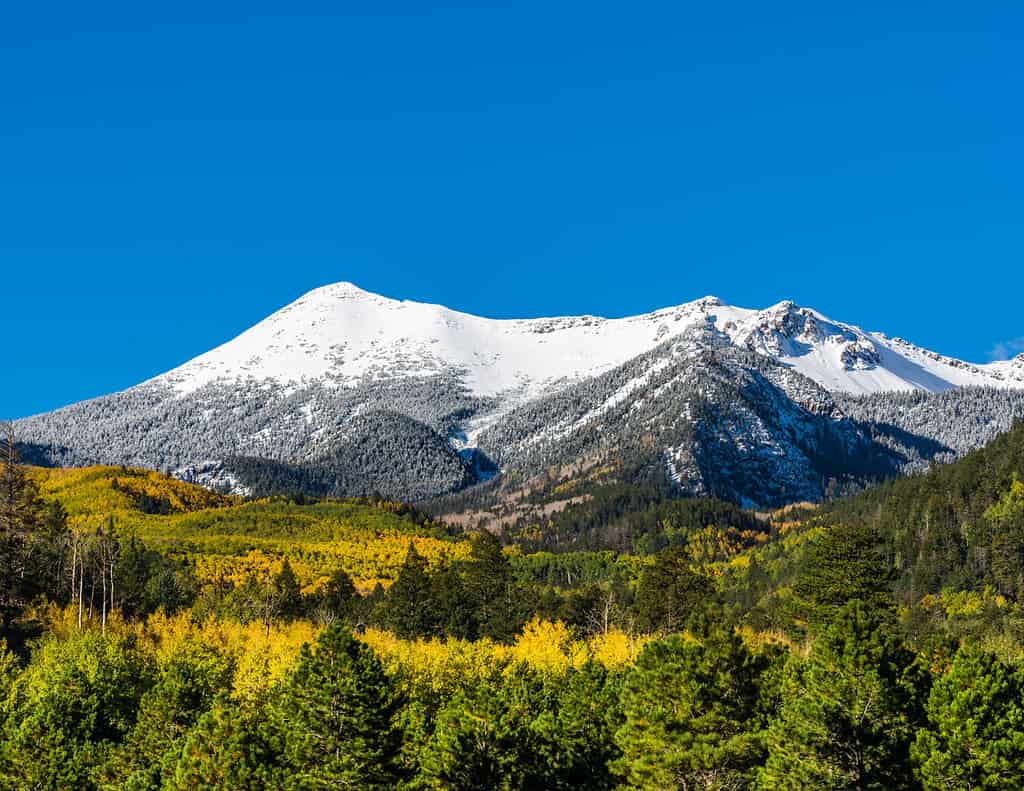
Humphreys Peak is named after Union General Andrew A. Humphreys.
©Kyle Benne/Shutterstock.com
The tallest volcano in Arizona has been a central figure to those living near present-day Flagstaff, Arizona, for centuries. But most importantly, Humphrey’s Peak is sacred to over a dozen Native groups, providing medicine, land to perform traditional ceremonies, and to connect them to their ancestors.
But in the 1500s, Spanish Conquistadors came to the area searching for gold. They called the peaks “Sierra Sinagua,” or Mountains Without Water. The name didn’t stick, and they moved into the Grand Canyon for precious minerals. Fast forward to 1629, the Franciscan Friars came to the area on mission trips to convert the Natives. They called the peaks “San Francisco Peak” in honor of Patron Saint Francis of Assisi. However, this name stuck, and the region was labeled “San Francisco Peak.” Today, it goes by San Francisco Mountain, San Francisco Peaks, or simply The Peaks.
Humphreys Peak is named after General Andrew A. Humphreys, U.S. Army officer and Union General during the Civil War. He later became a Corps of Engineers officer, but his most influential achievement was his report on the Physics and Hydraulics of the Mississippi River. The 500-page report covered the scientific and engineering principles to help control flooding of the Mississippi River.
Cultural and Spiritual Significance of Humphreys Peak
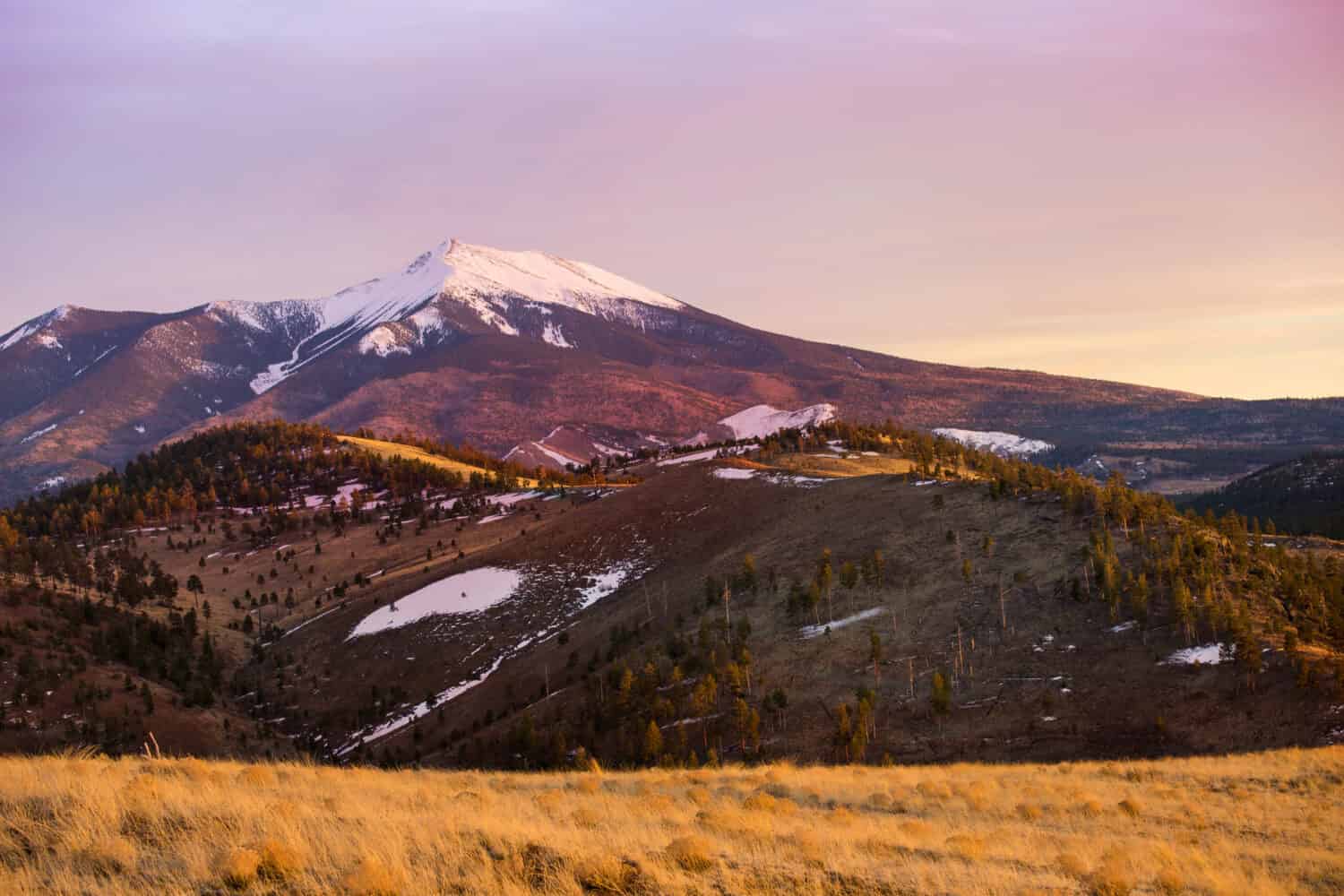
The tallest volcano in Arizona and the other San Francisco Peaks are sacred to the Native communities in Flagstaff.
©Matthew Mellinger/Shutterstock.com
The Peaks hold religious significance to at least 13 Native groups near Flagstaff, Arizona. Such groups include the Navajo, Hopi, Apache, Havasupai, Zuni, and others. Arizona’s tallest volcano has many names but represents life, emergence, and ancestry.
According to Navajo tradition, Humphreys Peak is known as Dook’o’oosłííd, meaning “the mountain that reflects.” In fact, it’s a spot where medicine men collect medicinal herbs and other vegetation used in traditional ceremonies. The Peaks contain sacred spaces among the trails and natural springs. To the Hopis, The Peaks are home to their katsinam, or ancestral deities. Humphreys Peak, in particular, plays a role in ceremonies, such as the Winter Solstice ceremony and everyday life.
The Peaks are more than just mountains. They are the foundation for religion and a way of life spanning generations. The vegetation growing on The Peaks is sacred and medicinal. However, commercial expansion in the area over several decades has impacted sacred teachings and the health of native wildlife.
When Did Humphreys Peak Last Erupt?
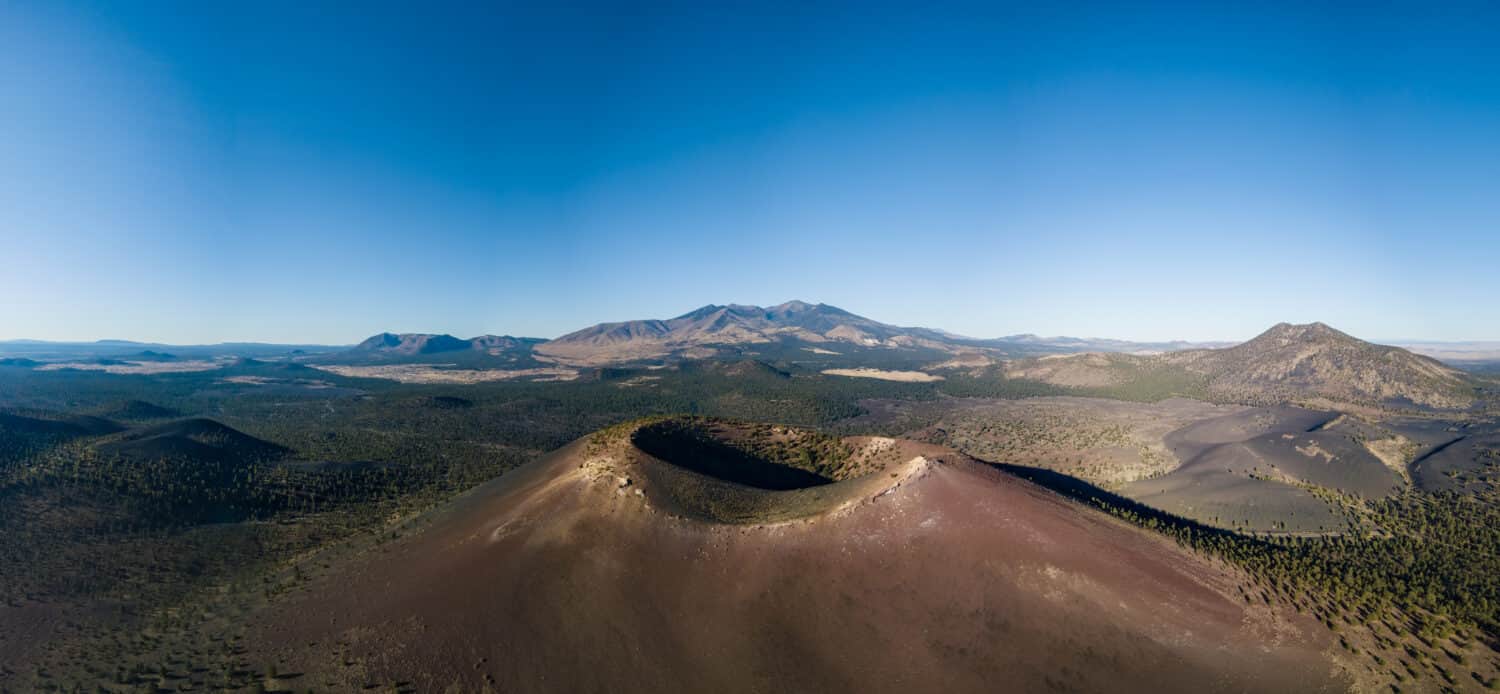
The last volcanic feature to erupt in the San Francisco Volcanic Field was Sunset Crater.
©Hakan Ozturk/Shutterstock.com
The San Francisco Mountain is a dormant volcano. Below Humphrey’s Peak are Mount Elden and Sunset Crater, two volcanic features in the San Francisco Volcanic Field. Sunset Crater last erupted nearly 1,000 years ago. However, Humphreys Peak and the rest of the volcanic features in the area have been dormant for about over 1,000. While the San Francisco Peaks are dormant, the San Francisco Volcanic Field is active.
Vegetation Around Humphreys Peak
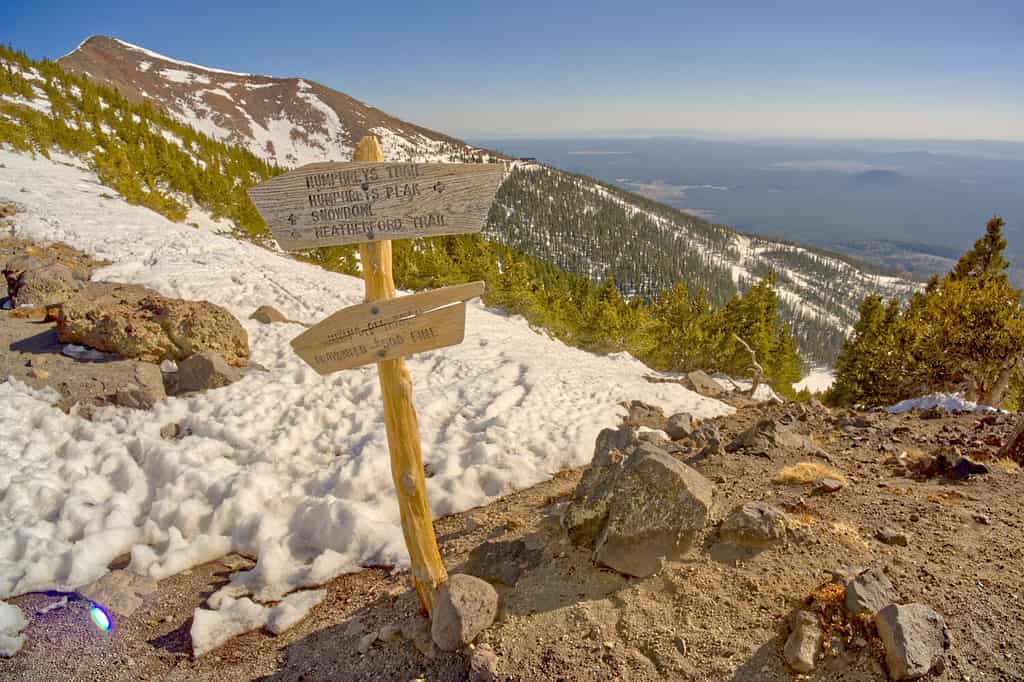
The trail around the tallest volcano in Arizona is over 10 miles roundtrip and takes up to 8 hours to complete.
©Cavan-Images/Shutterstock.com
One of the most popular spots of the tallest volcano in Arizona is the trail. The Humphreys Peak trail is 10.5 miles roundtrip. Hikers can see acres of Engelmann spruce, ponderosa pines, corkbark firs, and aspens along the way. The alpine forest covering Humphreys Peak is streaked with rock slides and avalanche tracks along its slopes. What’s more, you can see the scenic Hart Prairie stretching from the horizon for miles at the base of the Grand Canyon.
The higher the altitude, the harsher the terrain. Due to the seasonal wind and frost, the forest thins out, leaving mangled bristlecone pines behind. Above the treeline are only hardy plants capable of surviving. Small tundra shrubs and wildflowers cling near the slope’s rocks for support.
Reaching the Peak of Humphreys Trail is a challenging and rocky trek. But standing on the highest point of Arizona makes you feel like you’re standing on top of the world. The view from above gives you a 360 view of the Grand Canyon, the Hopi mesas, and the Painted Desert without obstruction.
Wildlife Around Humphreys Peak

See elk and other native Arizona wildlife by following the trail around Humphreys Peak.
©Tom Reichner/Shutterstock.com
There is plenty of wildlife surrounding the tallest volcano in Arizona. Wild turkeys, porcupines, and deer call The Peaks home. Larger mammals like bobcats, mountain lions, coyotes, elk, and black bears roam through acres of trees and other areas of the popular volcanic field. Many birds fly around, including western bluebirds, white-throated swifts, and chickadees. Larger birds flying overhead are golden eagles and red-tailed hawks. You’re guaranteed to run into at least one of these incredible animals anywhere along the Humphreys Trail.
Things to Do Near the Tallest Volcano in Arizona
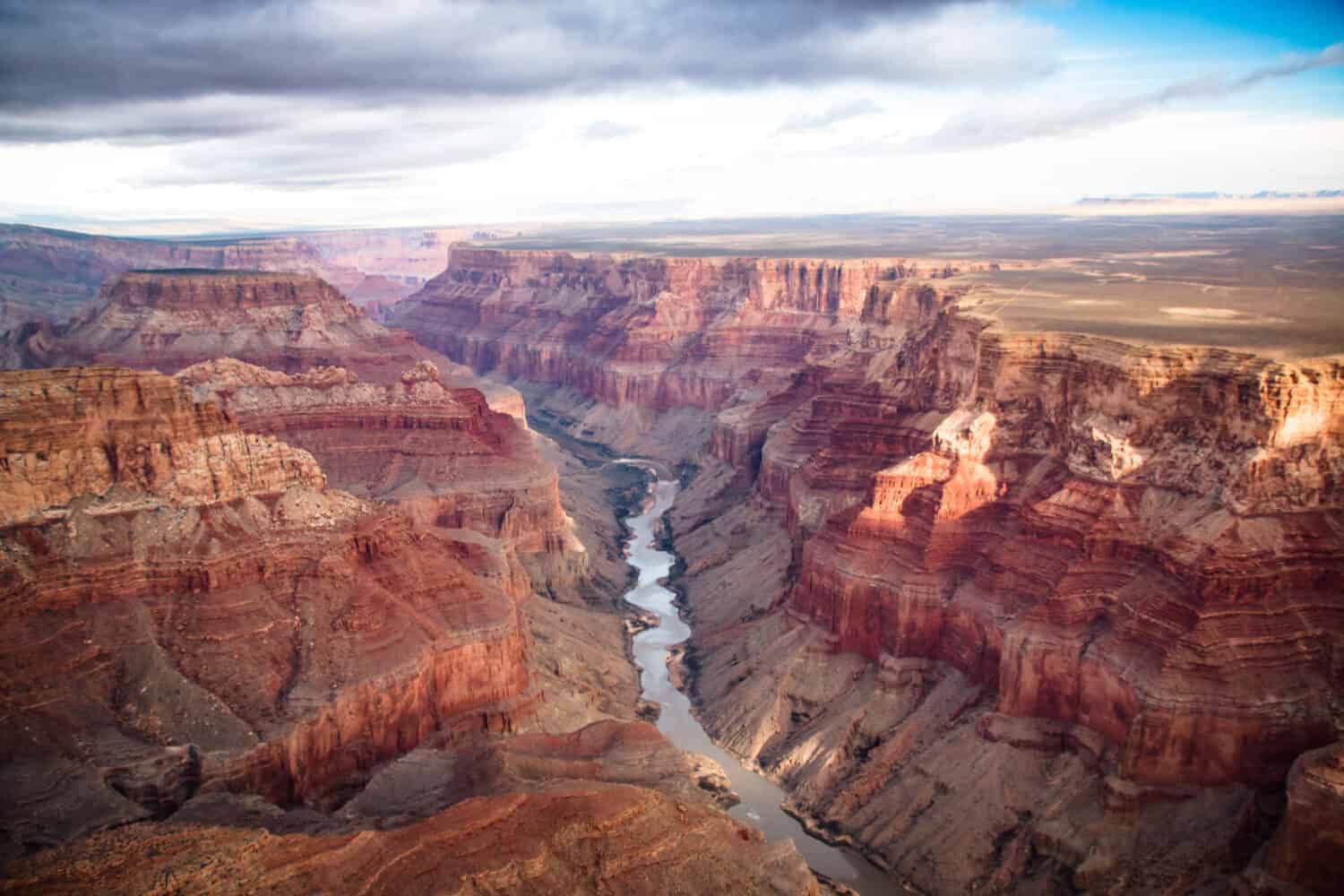
Get a better look at the Grand Canyon by taking a helicopter tour over the Grand Canyon National Park.
©Amanda Mohler/Shutterstock.com
Lowell Observatory
Visit the Lowell Observatory in Flagstaff to learn more about astronomy. Astronomer and mathematician Percival Lowell founded the non-profit research institution in 1894. Today, you can participate in solar viewing, science talks, demos, and historical tours. Six advanced telescopes give you a lifetime view of the stars. You won’t believe what the stars look like at night over Arizona.
Bearizona Wildlife Park
Get up close and personal with native Arizona wildlife in their natural habitat. Bearizona Wildlife Park is about an hour and a half from Humphrey’s Peak in Williams. They provide educational encounters with North American wildlife through a 3-mile drive-through or a 20-mile walk-thru area. Bearizona covers 160 acres of land and is home to more than 30 species, including the American bison, Rocky Mountain goat, and the javelina.
Grand Canyon National Park
Explore the 278 miles that make up Grand Canyon National Park. The National Park is about an hour and a half away from Humphrey’s Peak. Here, you can get a closer look at the erosion of the North and South Rim. There are many things to do, including hiking and backpacking through the wilderness, whitewater rafting, or getting a view higher than from the tallest volcano in Arizona by taking a helicopter tour.
Thank you for reading! Have some feedback for us? Contact the AZ Animals editorial team.








